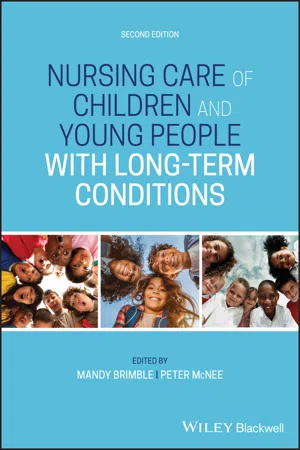
Nursing Care of Children and Young People with Long-Term Conditions
- English
- ePUB (mobile friendly)
- Available on iOS & Android
Nursing Care of Children and Young People with Long-Term Conditions
About this book
The second edition of Nursing Care of Children and Young People with Long Term Conditions remains the only nursing-specific text on the care of paediatric patients with chronic illness. Written to meet the needs of nursing students and professionals alike, this comprehensive volume provides authoritative and up-to-date information on the context, theory, and practice of delivering holistic care to children and families in a range of health and social care settings.
Contributions from a team of experienced academics, educators, and practitioners offer valuable insight into the impact of chronic illness on children and parents, the practical implications of meeting their physical, psychological, and social needs, empowering them to be 'experts' in their care, and many more vital aspects of long-term paediatric care. This edition features new and revised content reflecting contemporary guidelines and evidence-based practice, including updated clinical case studies and a new chapter examining the impact of having a sibling with a long-term condition. Emphasising a multi-disciplinary approach to managing chronic illness, this important resource:
- Provides numerous case studies and activities illustrating the application of theoretical principles and current evidence in nursing practice
- Investigates the genetic basis of chronic illness and the differing onsets of long-term conditions
- Discusses current political, economic, and social policies that are influencing healthcare for children and bringing challenges to managers and practitioners
- Examines both classic and contemporary theories of grief, loss, coping, and adaptation Explores ethical, legal, and professional aspects of nursing children and young people with chronic illness
- Addresses evolving nursing roles, the importance of acute emergency care, and the planning and delivery of effective transition from child to adult services
Nursing Care of Children and Young People with Long Term Conditions is required reading for student and registered children's nurses, as well as for practitioners in related health and social care disciplines.
Frequently asked questions
- Essential is ideal for learners and professionals who enjoy exploring a wide range of subjects. Access the Essential Library with 800,000+ trusted titles and best-sellers across business, personal growth, and the humanities. Includes unlimited reading time and Standard Read Aloud voice.
- Complete: Perfect for advanced learners and researchers needing full, unrestricted access. Unlock 1.4M+ books across hundreds of subjects, including academic and specialized titles. The Complete Plan also includes advanced features like Premium Read Aloud and Research Assistant.
Please note we cannot support devices running on iOS 13 and Android 7 or earlier. Learn more about using the app.
Information
CHAPTER 1
The Definition and Aetiology of Long‐Term Conditions
Introduction
Aim of the chapter
- Lead to a reduced risk of conditions occurring, or a reduction in severity for those where a condition has been identified.
- Enable them to fully participate in the relevant debates and ethical discussions that can have implications for children, young people and their families.
Intended learning outcomes
- To examine the hereditary influences upon the genetic basis of long‐term conditions in childhood
- To determine patterns of genetic inheritance
- To investigate the origins of long‐term conditions
- To explore the role of the children’s nurse during the period leading to, and at the time of, diagnosis
Genetic knowledge
Test your knowledge
- What are the two major phases of a somatic cell cycle?
- What are the four stages of mitosis?
- What are the subdivisions of meiosis 1?
- What are the products of meiosis 2?
- What are the three parts of a DNA nucleotide?
- What are the four nitrogenous bases in DNA?
- In what way does RNA differ from DNA?
- Cells contain three different kinds of RNA. What are they and what is their function in carrying out the instructions encoded in DNA?
- Do you understand the following terms? Haploid and diploid germ cell, homologous chromosomes, allele, heterozygosity and homozygosity?
Table of contents
- Cover
- Table of Contents
- Dedication Page
- Title Page
- Copyright Page
- Contributors
- Introduction
- CHAPTER 1: The Definition and Aetiology of Long‐Term Conditions
- CHAPTER 2: Context of Care and Service Delivery
- CHAPTER 3: Impact upon the Child and Parents
- CHAPTER 4: Impact On Siblings
- CHAPTER 5: A Holistic Approach to Meeting Physical, Social and Psychological Needs
- CHAPTER 6: Empowering Children, Young People and their Families
- CHAPTER 7: Ethical Issues
- CHAPTER 8: Children and Young People’s Continuing Care
- CHAPTER 9: Acute Emergencies
- CHAPTER 10: Adolescence
- CHAPTER 11: Transitional Care
- Index
- End User License Agreement